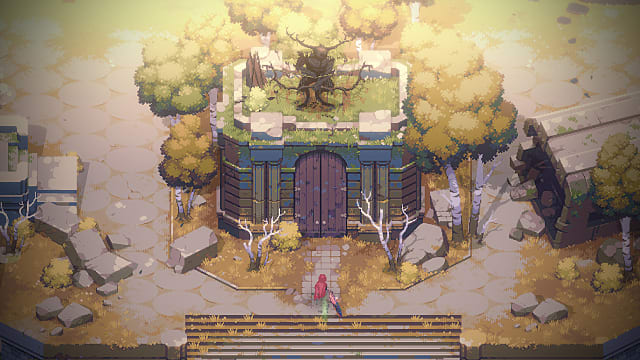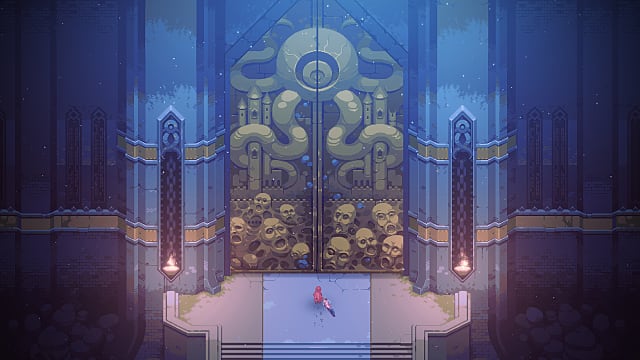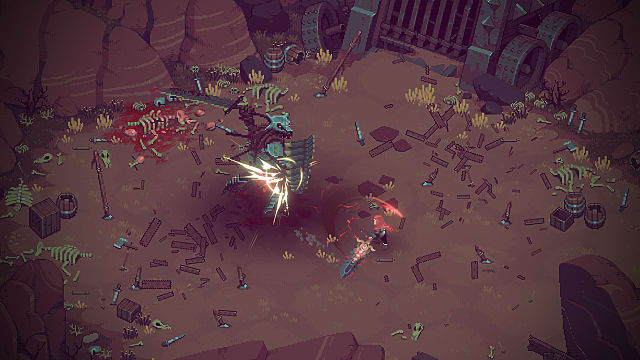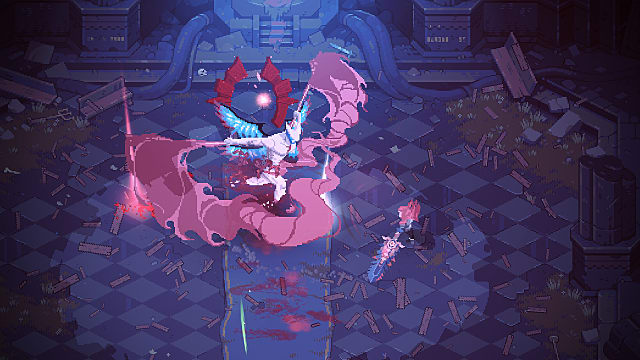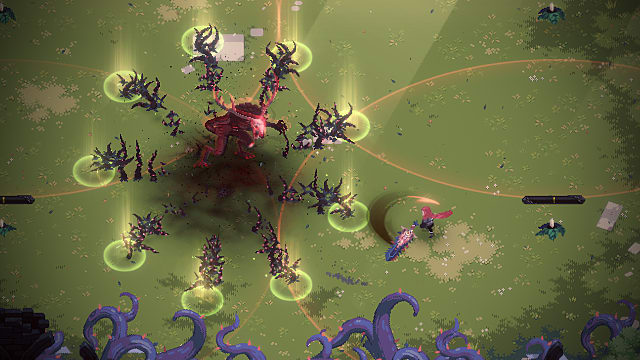There’s also the genre’s trademark storytelling on display here; it’s opaque, mysterious, and littered about the world rather than spoonfed to the player. Couple it with high quality (though not award-winning) pixel art and good music, and Eldest Souls makes for a tightly built game that’s worth your time.
The main issues arise in the gameplay, which is sadly the worst place for them to appear. Some wonky hitboxes and a few questionable design choices hamper the experience. The storytelling and world also aren’t as engaging as you might find in more narrative-focused Souls-likes.
None of this is a dealbreaker, but it did make for some frustrating moments during my playthrough.
Eldest Souls Review: Made With Love
As a boss rush game, the only enemies you fight in Eldest Souls are bosses with big health bars. There are no standard enemies, and the world is essentially empty except for one save point per area, several NPCs, and key item pickups scattered about.
Bosses, then, are generally good. There are 10 of them all told, and each is unique in both design and mechanics. Some use familiar aesthetics — ice, darkness, shapeshifting, and so on — but all of them have a few tricks up their sleeves. Good thing, too, because no boss has more than three attacks or so per phase, and they’re not hard to avoid once you know the dodge timing.
Each boss plays into its aesthetic quite well, using something as simple as “the darkness boss” and turning it on its head in new and exciting ways. Eldest Souls also plays with the mechanical expectations Souls veterans expect. Sure, the ice boss uses ice attacks, but it uses the arena as a weapon, too.
Like this, almost all of the bosses have some sort of arena mechanic, whether they be area-of-effect attacks, bullet hell projectiles, or something even meaner. Sometimes the arena gets in on the action, acting as a hazard or otherwise changing to make the fight more difficult.
Each boss fight is also unique enough that what you learn in one won’t necessarily translate to another. You will better understand how your build functions in a fight and the most optimal way to use it before relearning for another fight.
You’ll sometimes be able to learn about an upcoming boss based on the area they occupy. The ice boss lives at the end of an area frozen beneath a deadly frost. The animal boss lives deep in a corrupted forest. Sometimes the game gives you no clues, banking on the surprise of, say, a boss who uses light in a forgotten castle.
Learning the fights themselves doesn’t take too long; thankfully, the real challenges come from mastery, as with any group of good Souls bosses. The process is made much easier because the game provides a restart button, putting you right back into the action if you die. You can choose to go back to the area node to explore or take on another challenge.
It’s a nice feature and one that makes a lot of sense in a game without mooks to pester you from “bonfire” to “boss fog.” Having an instant-restart option also adds a bit of that “one more run” feeling you get out of a rogue-like. One failed attempt can quickly become 10 or 20, and unless you’re being bodied, you’ll have learned something with each death.
That knowledge won’t, necessarily, relate to how you play an encounter. I found the gameplay ultimately came down to spamming a specific set of actions and peppering in a special ability whenever it’s off cooldown.
With that in mind, the gameplay of Eldest Souls needs to complement every boss fight in some way. In many cases, parts of it only get in the way. There are three core issues that can make the moment-to-moment experience in Eldest Souls more tedious than enjoyable.
No Souls-like I’ve ever played got hitboxes right all of the time, so some of these issues I can forgive. One of the later fights sees a hitbox linger for more than a second after the attack animation finishes. In the same fight, an area of effect attack interacts oddly with the player character’s hitbox, making damage occur in an area larger than the attack animation itself.
At least for me, the bigger issue is the way boss hitboxes halt all momentum from the player. Rather than preserve forward motion as you move into a boss, like in a Miyazaki Souls game, if you run or dodge into an enemy in Eldest Souls, you just stop.
If one was occurring, your character’s animation also ceases, and suddenly whatever movement you had planned goes out the window.
Dodge invincibility frames don’t disappear, as the game still counts the dodge as having happened, so you can use this annoyance as part of a strategy in tight spaces. However, more often than not, the sudden shift of momentum put me on the back foot and sent me to the restart screen.
Many boss hitboxes also extend slightly above their pixel model or are otherwise deceptive to what they look like on screen. This exacerbates the collision issue and makes some arenas — many on the smaller side already — more dangerous to navigate.
Thankfully, these same janky hitboxes also make the bosses easier to hit. You’ll be able to do damage from ridiculous angles and distances. Your character’s sword also seems to extend about 50% longer than the model itself, which I’m sure helps.
Dodging is paramount in Eldest Souls. The primary difference in this game is that the stamina bar is divided into three chunks, and you can’t dodge unless at least one of them is full. Your stamina recharges significantly faster if you dodge through an attack, but if you’re caught with no charges, you’ll take damage unless you can do some fancy footwork.
I understand why the dodge charge mechanic exists as a risk-reward mechanic that encourages intelligent use of the ability, but two problems exists.
One: some situations demand multiple dodge uses, meaning you’re likely to be down a dodge with no way to get it back besides waiting.
Two: your character moves at a snail’s pace by default, and for most of the game, that will be their only speed. Eldest Souls is a fast-paced game, and it grinds to a snore when you can’t dodge. Dodging, therefore, becomes more than a survival tool: it’s a basic movement ability.
Upgrading your character in Eldest Souls doesn’t mean increasing your health or stamina or a pool of stats. Instead, there are three skill trees keyed to activated abilities, each of which modifies your character in some way, though mostly in how they deal damage.
At the higher levels of these trees, your charged attacks have effects of their own, which is good because your basic attacks are worthless. Charge attacks are further emphasized because they grant lifesteal, giving you back a portion of the damage you deal as health. Your sword glows bright red when charged, and it attacks faster and hits harder, so it’s easy to know when you’re using basic attacks.
Thanks to this reliance on charged attacks for DPS combined with an early game item that instantly refreshes the charge on use, I found myself eschewing most strategy and just wailing on bosses until they died. It wasn’t until very late into the game that I had to stop to dodge or rethink how I approached a fight. I could, in short, hit my head against most fights until I won.
Even though the gameplay was a bit more sour than sweet, the art, music, and story of Eldest Souls help make up for it. The game is beautifully drawn, though the player character is little more than a colorful collection of pixels. My only quibble is in the cutscenes. Even rendered at 1080p, the individual pixels are big enough that whatever they make up become something of a jumble.
Boss and area designs are incredibly well-realized, and each space has its own personality. It’s also clear from the aesthetic and level design that this world is long past its prime. The NPCs will tell you as much, but they’re merely driving the point home.
The music fits the world well, too, and each boss theme plays off of who they are, were, or represented. None of the tunes will win any awards for musical achievement, but they serve their functions to a T and set the mood well.
Last, the story is, in a word, opaque. You’ll need to read the various notes and item descriptions scattered about to understand the basics and then do some interpretation to arrive at a conclusion.
If you’re familiar with how Souls-games tell their stories, there’s nothing unfamiliar about the approach. As for my opinion on the story, it’s interesting, though I didn’t find it as engaging as others in the genre.
Eldest Souls Review — The Bottom Line
Pros
Awesome boss fights that all feel unique and satisfying to overcome Beautiful pixel art that creates a world worth exploring Good music and Souls-like story that ask just enough of the player
Cons
Several gameplay decisions get in the way more than they help Samey combat that demands less than it should Janky hitboxes
Eldest Souls is a game with great bosses that’s somewhat held back by spotty gameplay design decisions. Its aesthetics are solid, and it’s clear the development team put their heart and soul into making the best boss rush Souls-like they could.
They succeeded beyond most expectations, crafting a world wracked by ancient cataclysms and occupied by beings of terrifying power. It’s also a world you’ll want to explore despite its small size, as the challenges and mysteries buried at its heart are captivating enough to demand investigation.
For fans of the Souls-like genre who want to test themselves against the gods of a forsaken land and uncover the world’s secrets, Eldest Souls provides.
[Note: Fallen Flag Studio provided the copy of Eldest Souls used for this review.]
